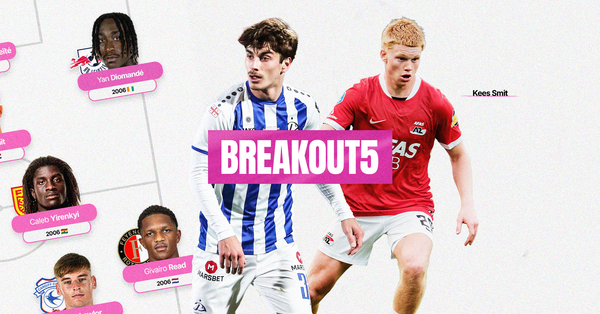An introduction to the Gamebreaker
The first winger Archetype - inspired by Mohamed Salah
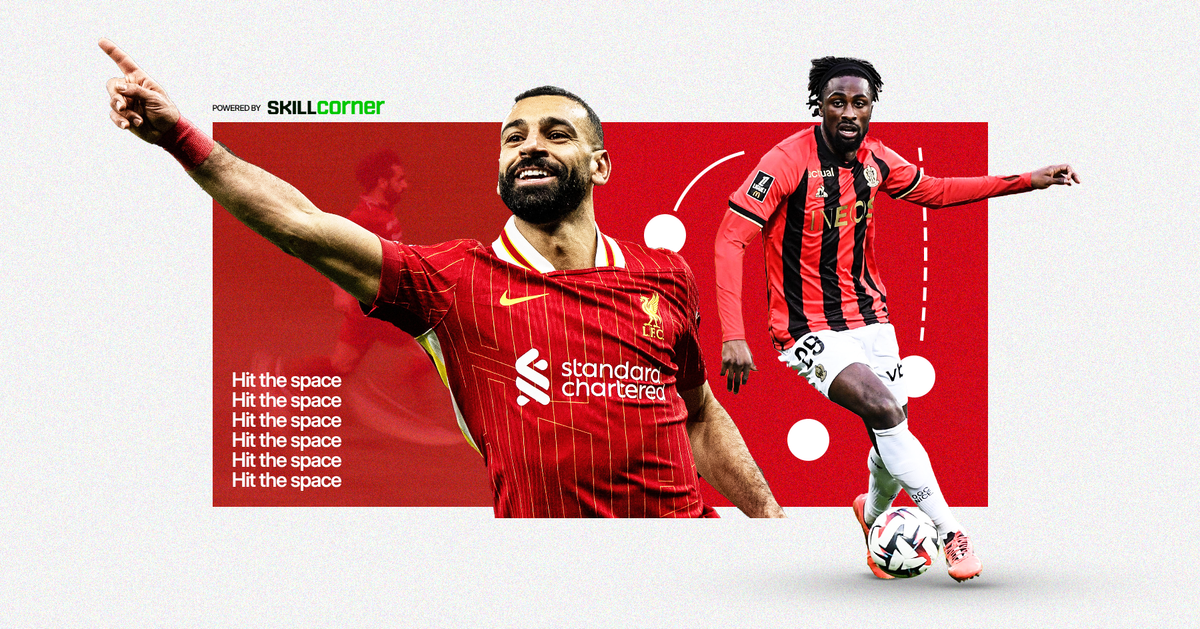
Mohamed Salah has signed a new contract at Liverpool. Soon, he will set the record for most goals and assists combined in a single Premier League campaign. Now is the perfect time to explore the Egyptian’s profile with SkillCorner data and workshop the Gamebreaker Archetype.
This article was made free to read thanks to support from our data partners, SkillCorner. If you'd like to help our independent research, analysis and journalism survive, drop us a one-off tip - or subscribe to unlock everything SCOUTED write.
Gamebreaking Athleticism
Let’s start with speed. Salah ranks in the 90th percentile for PSV-99 and the 98th percentile for Top 5 PSV-99. Not only is Salah consistently quick, but his athletic capacity is enormous. This physical condition is perhaps one of the main reasons there were no hesitations to renew the deal of a player set to turn 33 in the summer. But how do we characterise a Gamebreaker’s physical output beyond pure pace?
Well, one of my initial theories for the profile included a way to paint ‘luxury’ players in a positive light - or at the very least, not a negative one. In the world of SCOUTED Archetypes, luxury could come to mean a player that saves their Physical output for In Possession (TIP). This does not necessarily mean they cannot or will not contribute Out of Possession (OTIP), but rather their merit in attack is so valuable that maximum effort is reserved for those moments. Salah’s data supports this theory.
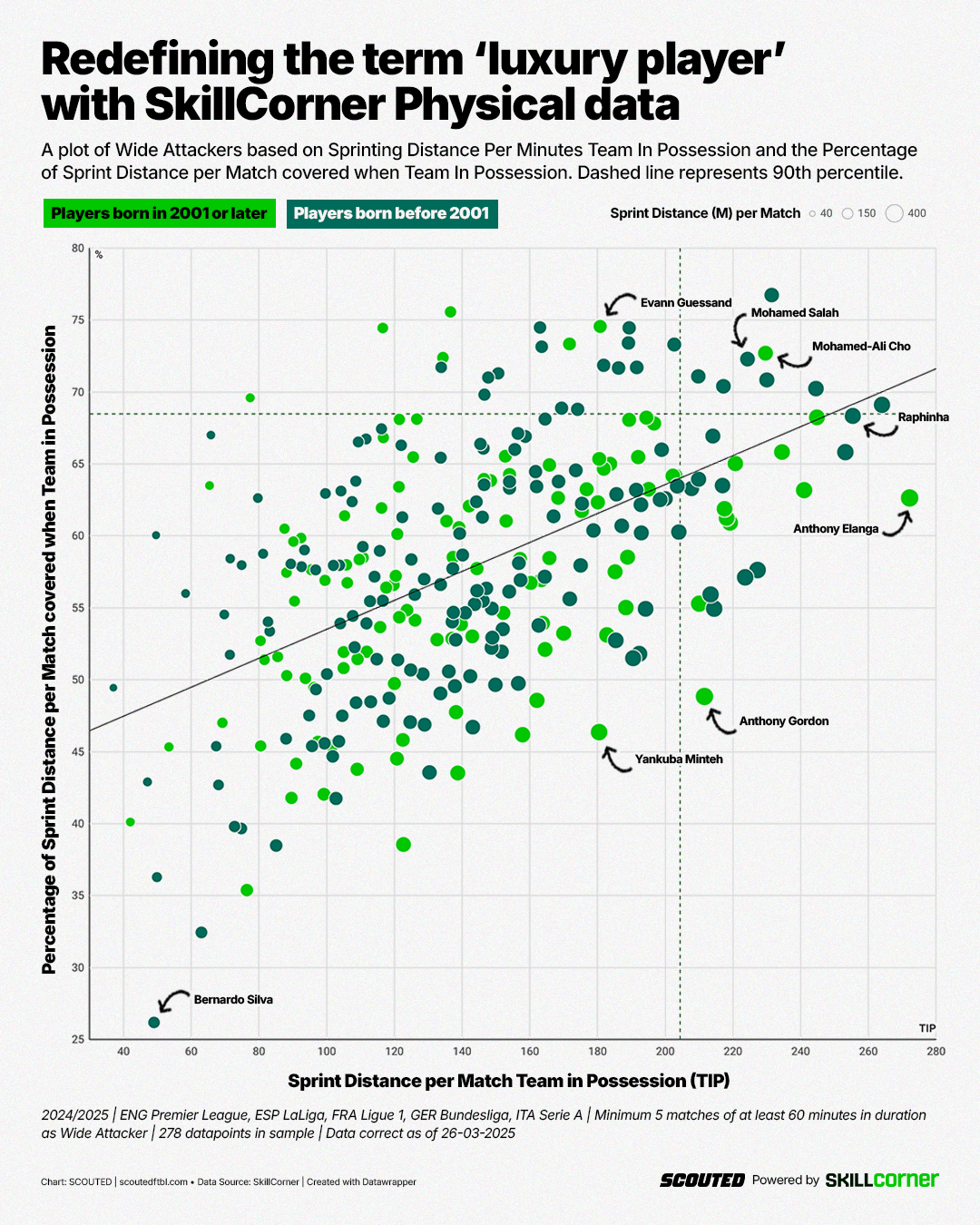
72.3% of his Sprinting Distance per Match and 67.3% of his Sprints per Match are logged while his team has possession of the ball (TIP). These are both top 5% figures within our dataset. For further context, Rafael Leão makes the highest percentage of his Sprints when In Possession while Bernardo Silva makes the fewest.
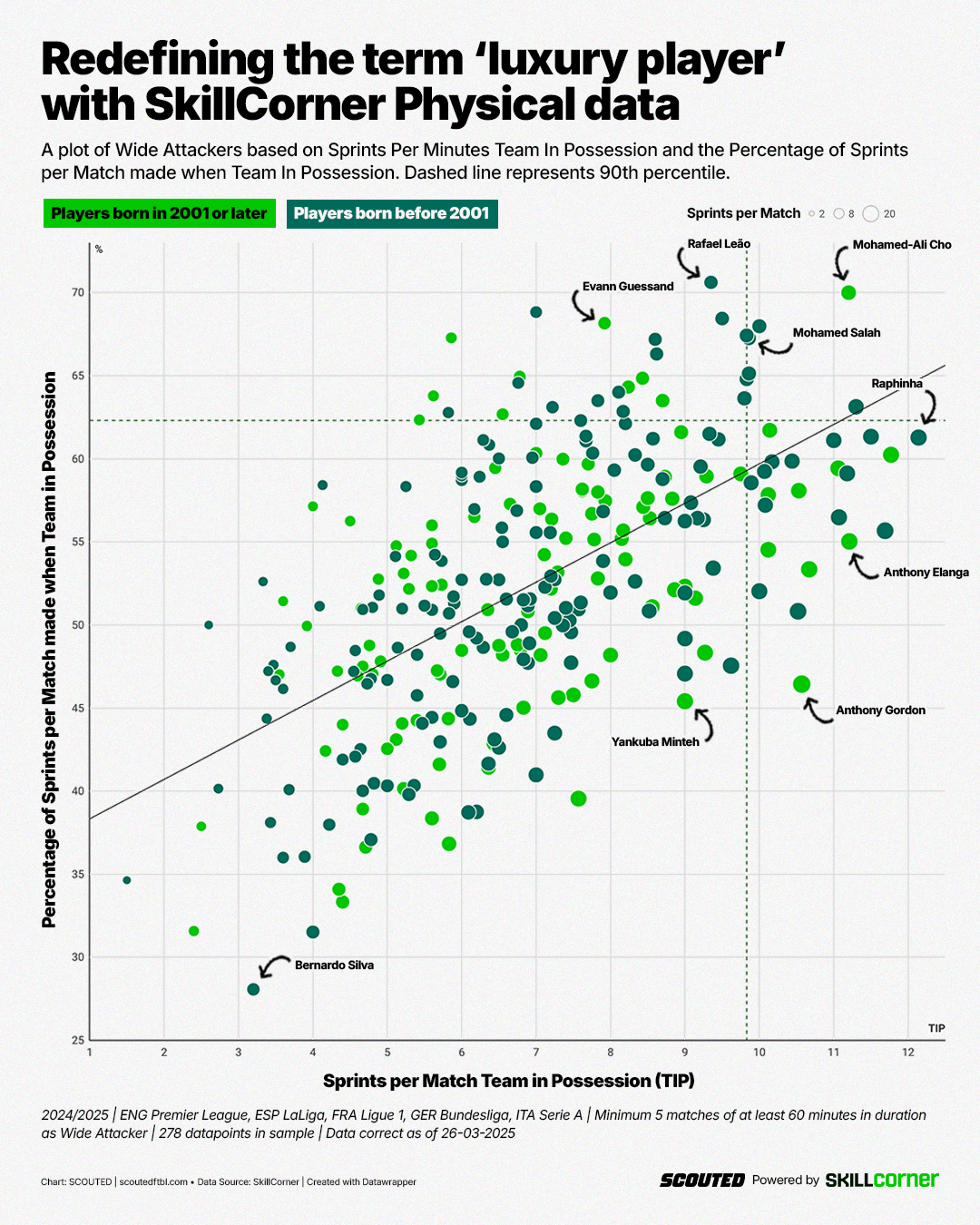
To discover Gamebreaking Physical profiles then, focus on physical capacity, rather than pure volume. Salah ranks in the top 15% for the following metrics:
- Top 5 PSV-99
- Top 3 Time to Sprint
- Distance per Sprint
- Percentage of Running Distance per Match as Sprinting Distance TIP
- Percentage of Sprints per Match as Sprints TIP
These emerge as our core metrics in the quest to discover players with the ability to break a game in a specific moment.
Gamebreaking Style of Play
Having established that Salah makes quick, large Sprints in Possession, now it is time to explore the byproduct of those actions. For this, we will look at both Off-Ball Running and Passing in tandem.
First, although it may not surprise you to learn, I wanted to highlight that the three Run Types responsible for generating the most Threat are Cross Receiver Runs, Runs In Behind and Runs Ahead of the Ball. These are also the three most common Run types for Wide Attackers. As the Gamebreaker concept was born out of an attempt to discover the secret of Salah’s outrageous goal and assist output, it makes sense to focus purely on these Runs for this profile. Again, Salah’s own profile supports this decision.
The segment in the top right of the graph below contains the five players that rank in the top 10% for Gamebreaker Share of both Off-Ball Running and Passing: Mohamed Salah, Iñaki Williams, Dango Ouatarra, Evann Guessand and Yankuba Minteh.
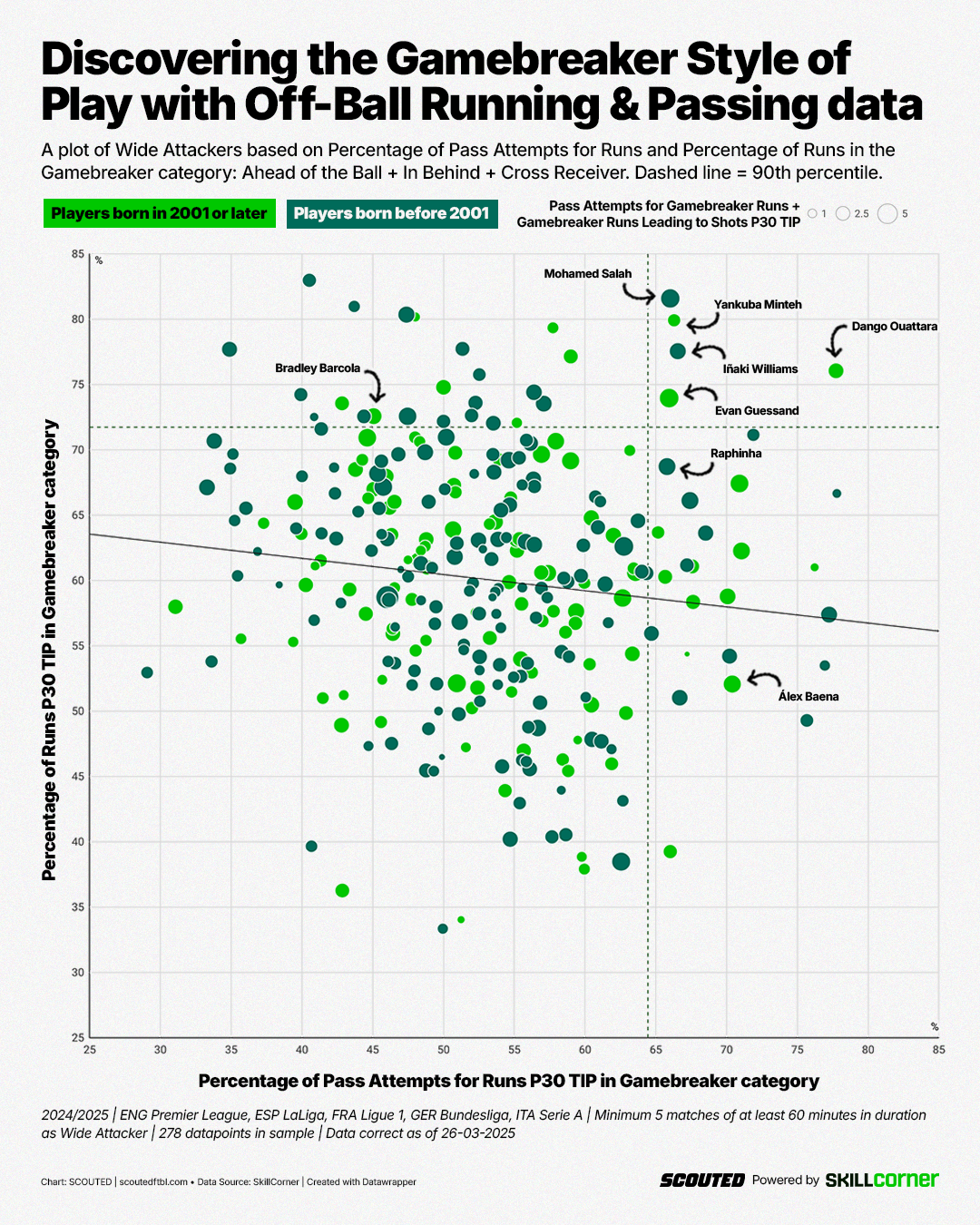
Of those five, only Salah and Guessand rank in the top 10% for Gamebreaker Run + Pass Attempts Leading to Shots P30 TIP. In fact, they are two of four players averaging 4+ in this metric alongside Eberechi Eze and Ademola Lookman.
Focussing on this proportion of Gamebreaker Runs and Pass Attempts helps to define a Gamebreaking style of play. Meanwhile, the volume of these metrics which Lead to Shots becomes valuable in evaluating the elite exponents of that style.
We also begin to create a spectrum of Wide Attackers: those that break the game open with their Runs - Bradley Barcola - and those that break the game open with their Passing - Álex Baena. But even then, not every player breaks the game in quite the same way.
Salah’s Superpower
To further distinguish the style of each player, we can look at the three Run types that make up the Gamebreaker Combo: Ahead of the Ball, In Behind and Cross Receiver. From watching Salah, my theory has always been that his outrageous output is tied to his relentless running and passing into space beyond the defensive line. Fortunately, this is essentially the SkillCorner definition for Runs In Behind.
Earlier, we established that beyond the volume of Gamebreaker Runs and Pass Attempts for these Runs, focusing on those that Lead to Shots could be useful to discovering Gamebreaking Wide Attackers. By looking specifically at this metric and breaking it down by Run types, as we did in the previous section, we discover that Salah’s most devastating means of breaking a game is Runs In Behind.
To hammer home this point, allow me to dip into a different dataset.
Among 334 Wide Attackers in the Premier League since 2018/19, only nine players rank in the top 10% for Runs In Behind Leading to Shots per Match and in the top 10% for Passes Completed for Runs In Behind Leading to Shots per Match in a single campaign. Mohamed Salah is responsible for three of his entries: 2022/23 Salah, 2023/24 Salah and 2024/25 Salah. When combining these two metrics, Salah is responsible for each of the top four tallies. All seven of his seasons in this timeframe make the top 30.
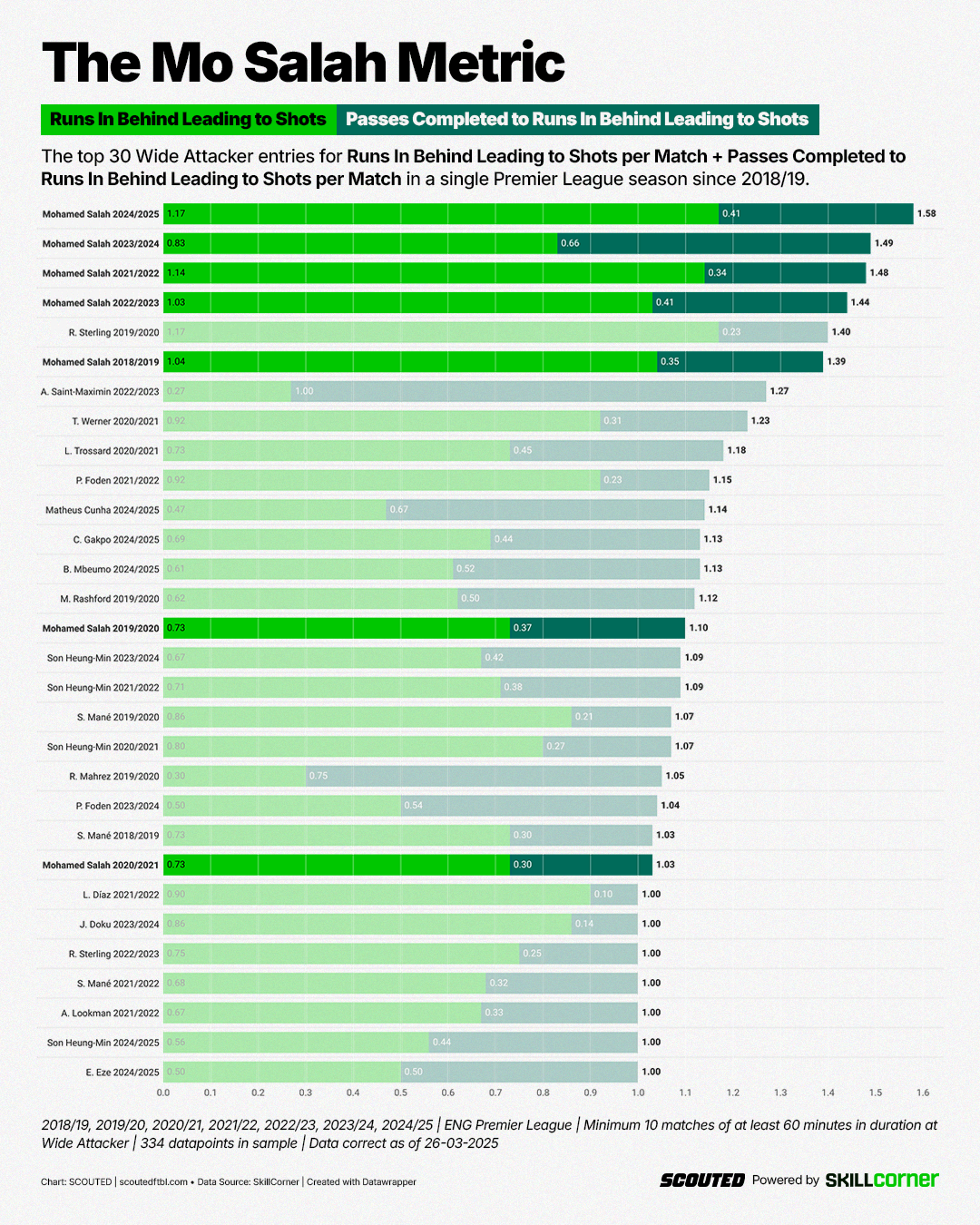
The reason I looked at Per Match stats is because this is what is happening in the game and emphasises how Salah is breaking it. To discover players that might have the potential to replicate this output in a similar environment - i.e. seeing more of the ball In Possession per Match - we can use the Per 30 Minutes TIP filter.
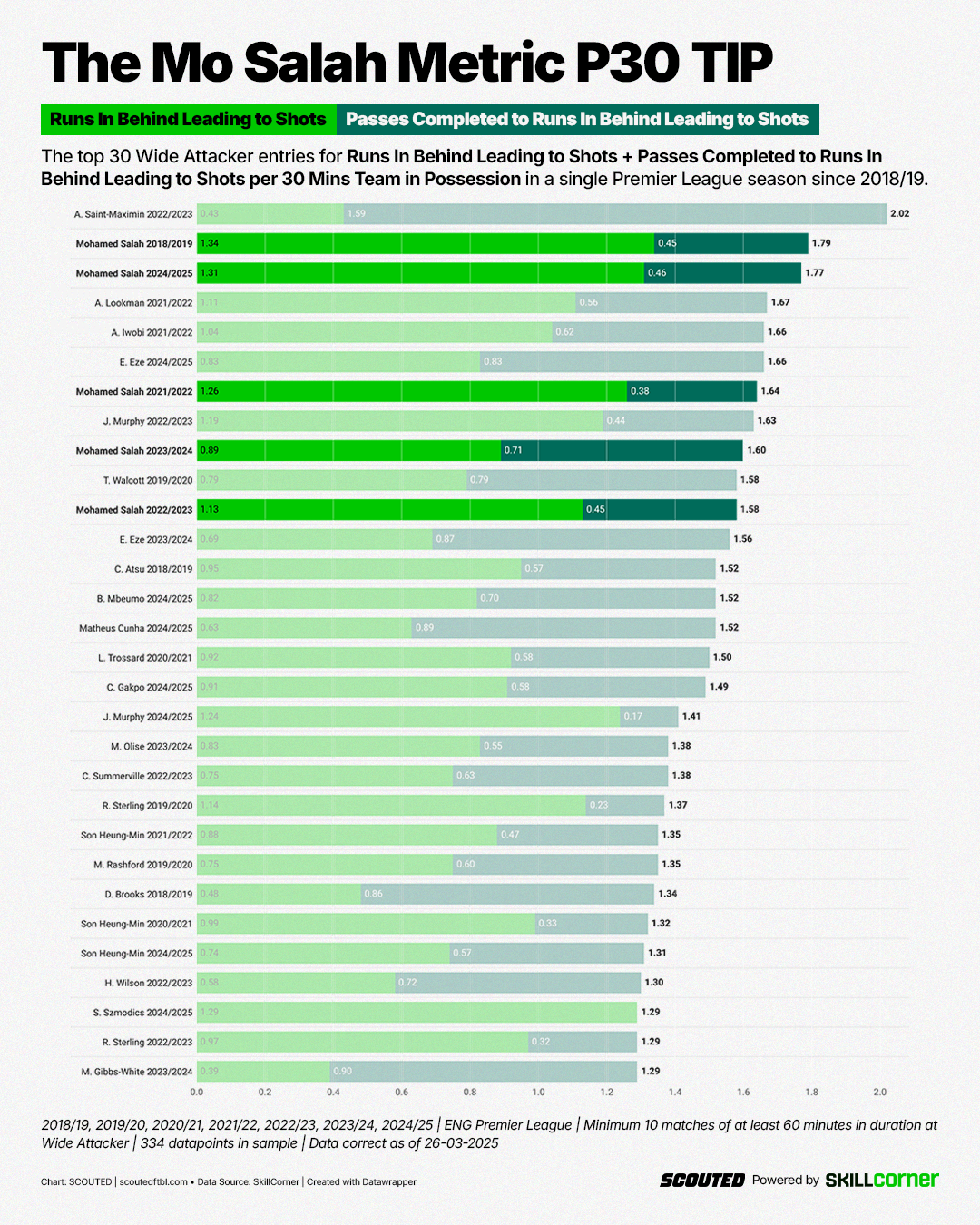
That being said, Salah is still responsible for the top two entries for Runs In Behind Leading to Shot P30 TIP in a single Premier League campaign since 2018/19. When combining the metrics, only Allan Saint-Maximin’s 2022/23 campaign can beat Salah. The intriguing difference is that 78.7% of the Frenchman’s tally was accumulated through Passes to Runs In Behind, almost the exact inverse of Salah’s splits from 2018/19 and 2024/25.
At first glance, Salah and Saint-Maximin appear to be at opposite ends of the Wide Attacker spectrum that is emerging. The Egyptian leans on Runs while the Frenchman relies on Passes for Runs. However, the average Wide Attacker's proportion of Gamebreaker Runs + Passes as Runs in our dataset is 79.1%; Salah's highest proportion from the list above is 76.8% (2021/22) while he dropped as low as 55.6% in 2023/24.
I think it is therefore fair for us to say that a true Gamebreaker tries to do both. Revisiting the 2024/25 Big Five League dataset further validates that concept.
Salah’s Secret Sauce
In terms of style, Salah is the only player that ranks in the top 10% for Percentage of Runs as Runs In Behind and Percentage of Pass Attempts for Runs as Pass Attempts for Runs In Behind. In terms of volume, Salah ranks in 95th percentile for Pass Attempts for Runs In Behind and 79th percentile for Runs In Behind. But as a combined metric, he ranks in the 90th percentile.
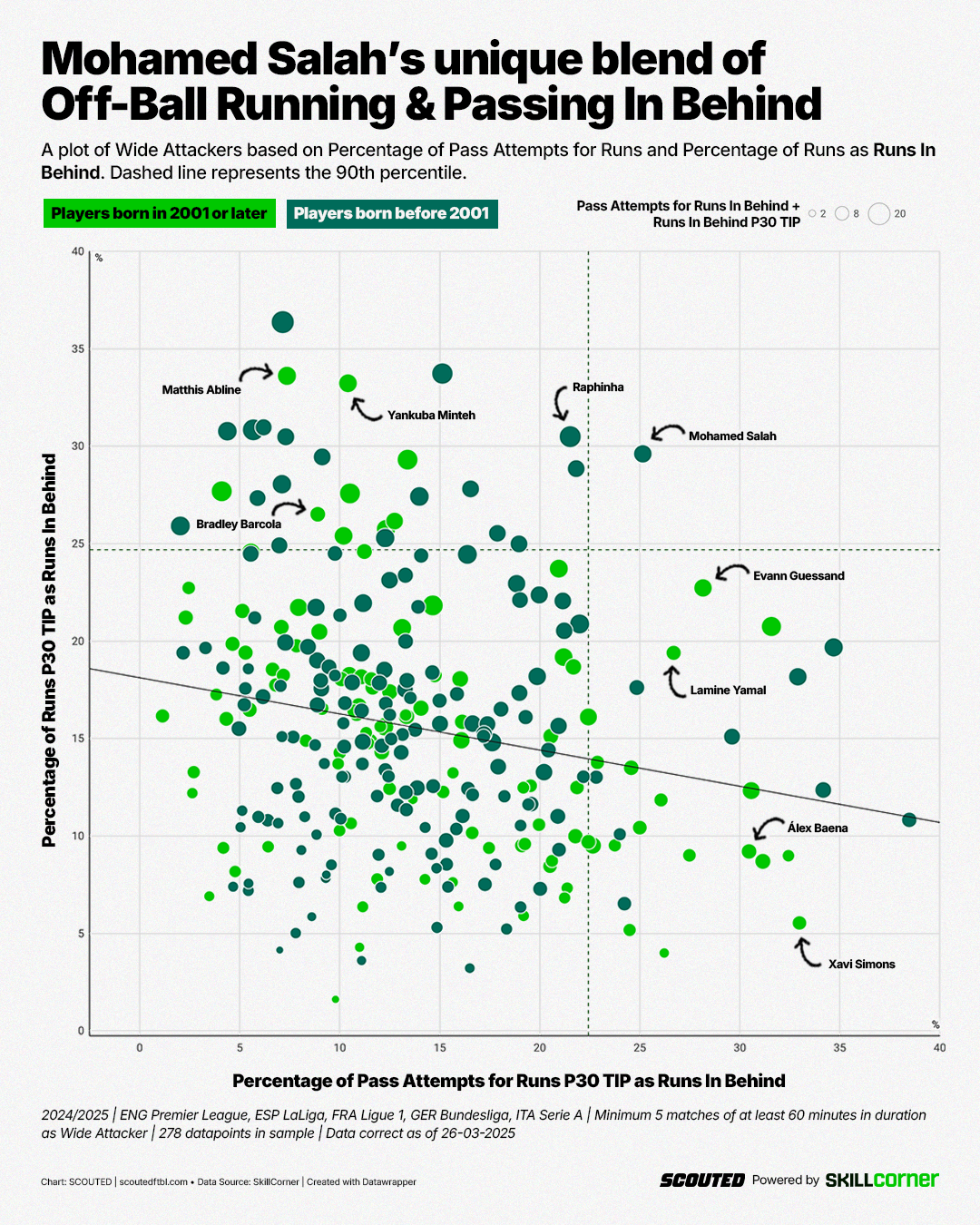
This is what separates a Gamebreaker from the average Wide Attacker: they index into both Runs In Behind and Passes to Runs In Behind. This is not the norm. The trendline on the graph suggests that the larger proportion of Runs In Behind, the smaller proportion of Pass Attempts for Runs In Behind. That makes logical sense considering you cannot do both at the exact same time. Salah is breaking the game and this logic.
Furthermore, the discoveries in the introductions to the Power Forward and Full-Back Archetypes also apply to the Wide Attacker positional group. The fastest players, like Salah, tend to make more Sprints and make more Runs In Behind. There is also a positive correlation between PSV-99 and the Threat of Runs In Behind as well as the number of Runs In Behind that are Targeted by teammates. This all checks out for the Egyptian. However, the usual passing profile linked to this style is Pass Attempts for Cross Receiver Runs.
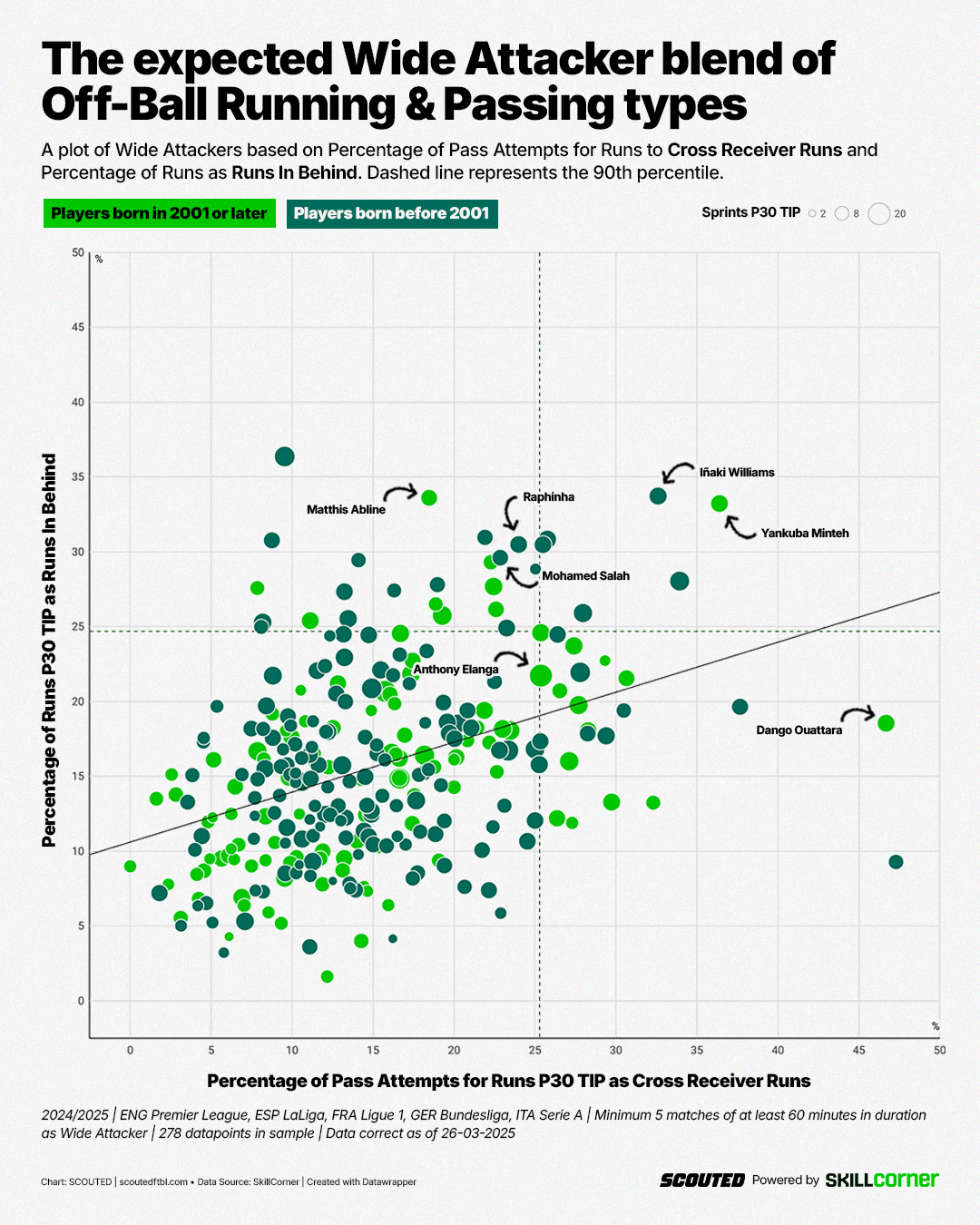
Now, while Salah still ranks well when looking through the conventional lens, he also breaks the mould. Salah ranks in the 86th percentile for Percentage of Pass Attempts for Runs as Pass Attempts for Cross Receiver Runs - style - and the 92nd percentile for Pass Attempts for Cross Receiver Runs - volume. However, only eight players rank in the top 20% for both Pass Attempts for Runs In Behind and for Cross Receiver Runs. Of those eight, only three rank in the top 20% for Percentage of Runs In Behind: Mohamed Salah, fellow 2024/25 Ballon d’Or contender Raphinha and 2002-born Gaetano Oristanio.
Salah does not just profile as an explosively quick, cross-happy Wide Attacker - a Roadrunner Archetype begins to take shape - but he also profiles as a player that supplies those players - a Safecracker, perhaps? Finally, the question we need to answer becomes:
What is a Gamebreaker?
Should a Gamebreaker represent a player that is operating at an elite level across multiple profiles? Could ‘Gamebreaker' become a SCOUTED synonym for complete? After all, Salah is the Poster Boy for this concept because he is a triple threat.
In this dataset of 278 Wide Attackers across Europe’s Big Five Leagues, only five players rank in the top 10% for Gamebreaker Runs Leading to Shots and Passes Completed for Gamebreaker Runs Leading to Shots:
- Mohamed Salah
- Luis Díaz
- Ademola Lookman
- Evann Guessand
- Eberechi Eze
Of those five, Mohamed Salah is the only one that also ranks in the top 10% for PSV-99. His physical profile elevates him to a realm beyond the rest.
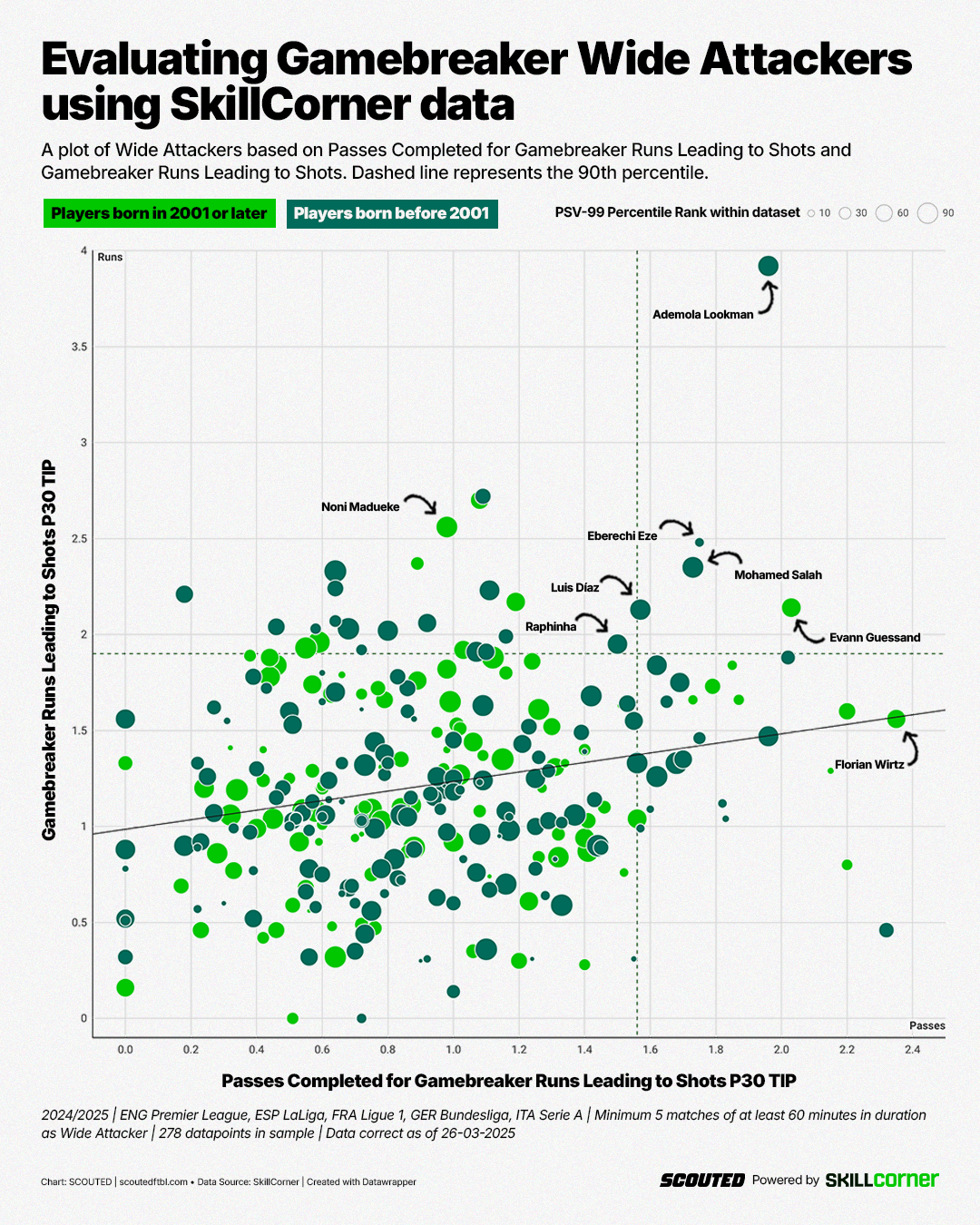
However, Salah is also a Gamebreaker because of his logic-defying means of reaching these thresholds: he is breaking the Archetype game we are trying to play. It is possible to reach these thresholds through conventional means. Luis Díaz, for example, appears on the list despite playing just 4.2% of his Passes for Runs In Behind, as expected from a Roadrunning winger. Meanwhile, Lookman’s and Eze’s profiles look like a solid foundation for the Safecracker Archetype. Salah and Guessand, however, embody the Gamebreaker style.
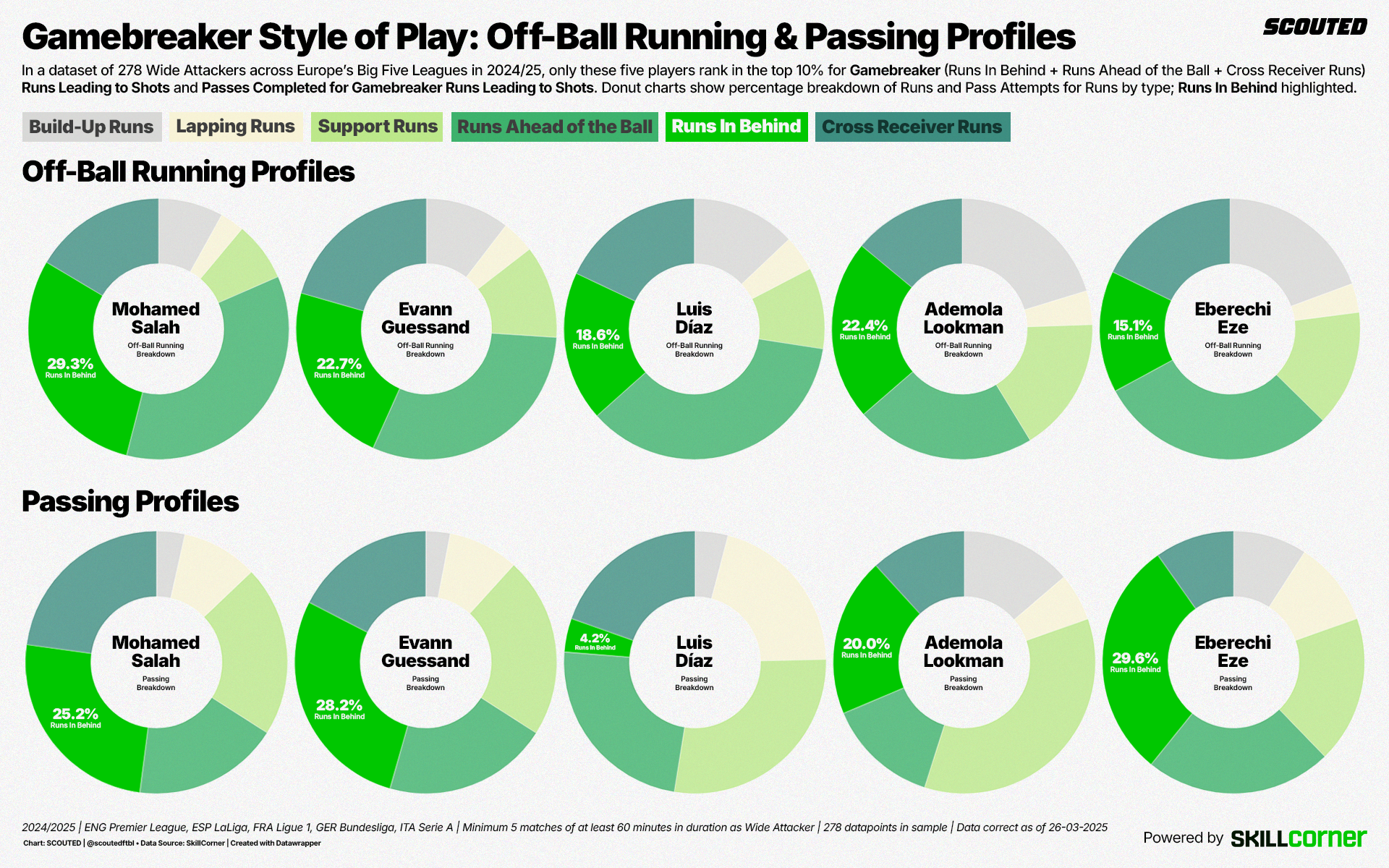
Salah and Guessand are the only two that rank in the top 10% for Percentage of Pass Attempts for Runs and the Percentage of Runs in the Gamebreaker category. Meanwhile, the intent to break the last defensive line with both Runs and Passes is the calling card; Salah and Guessand rank in the top 15% for Runs In Behind as a percentage of both their Running and Passing profiles.
This is the Gamebreaker Archetype. This is why Liverpool were desperate to extend Salah’s contract. And this is why we’ll be keeping a serious eye on Guessand.
This newsletter was produced under a commercial collaboration with SkillCorner, SCOUTED’s official data partners. Their tracking and performance data is used by more than 150 of the world’s biggest clubs, leagues and confederations.




